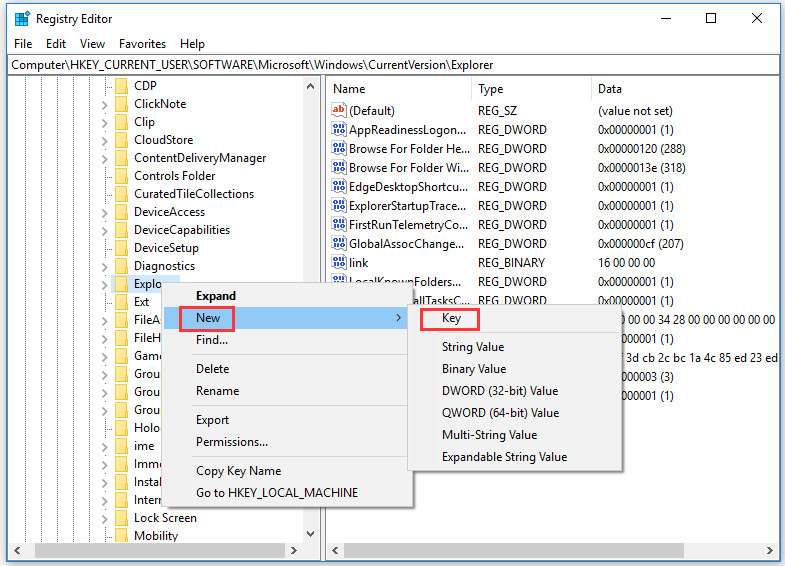How To Create Registry Key In Windows 10
- MiniTool >
- MiniTool News Center >
- How to Create, Add, Change, Delete Registry Key Windows 10
How to Create, Add, Change, Delete Registry Key Windows 10 [MiniTool News]
By Alisa | Follow | Last Updated
Summary :

In this tutorial, you will learn how to create/add a registry key in Windows 10, as well as how to change/modify a registry key or delete a registry key in Windows 10. To back up operating system, files and folders in your Windows 10 computer and restore system or files when needed, MiniTool ShadowMaker from MiniTool is a great helper.
Sometimes you may need to do some editing in Windows Registry to fix some problems related to your computer hardware or software. You may want to add a registry key in Windows 10, change a registry value, delete a registry key, etc. This tutorial provides a detailed guide on how to create/modify/delete registry key in Windows 10.
You should back up the whole registry database before you modify the registry. This can help restore to the original settings from backup if something goes wrong.
To back up the entire registry database, you can open Registry Editor in Windows 10, click File -> Export in Registry Editor, and input a file name to save the registry file. The exported registry file has a .reg extension by default.
Alternatively, you can also create a system backup with MiniTool ShadowMaker and restore system to a previous state if your system crashes.

Learn how to backup and restore registry in Windows 10 (2020 guide). You can backup and restore Windows 10 registry manually or with a restore point.
You can check below how to edit registry key in Windows 10 with Registry Editor.
How to Add a Registry Key or Value in Windows 10
Step 1. You can press Windows + R, type regedit in Run windows, and click OK to open Windows Registry Editor.
Step 2. Navigate the left pane of Registry Editor to find the registry key in which you want to add a subkey or want to add a value to.
Step 3. To create a new registry key, you can right-click the key and select New -> Key. Then name the new registry and press Enter to create a new registry key.

If you want to create a new registry value under a registry key, you can click this registry key and right-click the empty space in the right window to choose New and choose a Value type. Then type a name for the value and double-click it to set the preferred value data.

Guide on how to clean registry in Windows 10 manually or by using free registry cleaner Windows 10. Backup OS, data and registry before cleaning Registry.
How to Change/Modify/Delete a Registry Key in Windows 10
You can also modify the existing registry keys like renaming, changing the value of registry key, etc.
To rename a registry key or value, you can right-click the registry key or value and choose Rename to enter the new name.
To change the value data of registry key, you can right-click the registry key and select Modify to set a new Value data.
To delete a registry key, you can also right-click the target registry key and select Delete.
After you make the changes, you may need to restart your computer to make these changes take effect.

How to Modify Registry Key in Windows 10 with Command Line
If you are good at using Command Prompt, you can also use command lines to modify registry keys. Popular commands related to Registry handling include:
- Reg add: Add a new subkey or entry to the Registry.
- Reg copy: Copy a subkey to another subkey.
- Reg delete: Delete a subkey or entry from the Registry.
- Reg export: Create a copy of specified subkeys, entries, and values into a file in REG format.
- Reg query: Display the data in a subkey or a value.
- Reg import: Merge a REG file containing exported Registry subkeys, entries, and values into the Registry.
- Reg restore: Write saved subkeys and entries in hive format back to the Registry.
- Reg save: Save a copy of specified subkeys, entries, and values of the Registry in hive (binary) format.
You can type the command Reg /? in Command Prompt window to list all available commands.

How to disable access to Windows Registry? Should I disable network access to Windows Registry? Check the 2 ways to prevent access to Registry Editor.
Bottom Line
You can easily create/change/delete registry key in Registry Editor if you know how to do it. But you should not randomly edit the registry if you don't know what the registry key does, in case your computer becomes a brick.
How To Create Registry Key In Windows 10
Source: https://www.minitool.com/news/create-change-delete-registry-key.html
Posted by: tranwastookey.blogspot.com

0 Response to "How To Create Registry Key In Windows 10"
Post a Comment